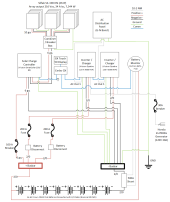Great comments from all. Thank you!
You need a 200A Class T fuse between the battery and positive bus bar (as close to the battery as you can).
Will add this. Good catch.
Now I am looking at the wiring through the battery bank to the busbars and from the busbars to the inverters, which I realize is undersized in the drawing. I'm using the calculations from
AltE and would appreciate knowing if I've missed anything.
The Quattros are rated at 3000W continuous, 6000W peak, 48V. Looking at one circuit, which let's say can be kept < 10 ft round trip from the Quattro through the busbars and back up to the Quattro, and basing the calculation on the 6000W peak (125A*48V), and using the VDI calculation from AltE:
VDI=(AMPS*FT)/(VOLTAGE DROP*VOLTAGE). Assume a <1% desired voltage drop: VDI=(125*10)/(1*48)=26. From the table, 2 AWG wire looks good. And from the max amperage table, 2 AWG can take 130A, so that works. Couple that with a 130A breaker like
this, and are we good to go?
Now for the wiring through the battery bank (bridging the batteries) and to both busbars: This circuit is driving both Quattros, so I'd have to double the current. I believe I can build a battery box that limits the total cable length between busbars to <10 ft:
VDI=(250*10)/1*48)=52. From the table, 1/0 can take the VDI, but it's only good for 170A. I was planning on using 2/0, which is only good for 195A. I would have to use 4/0 cable to be able to accommodate 250A.
1. Am I thinking about the bridge wiring between batteries correctly?
2. Am I right in sizing the wiring for the surge capacity of the inverters?
3. Any feedback on the 130A
breaker?
The inverter branch circuits should be fused before the disconnect switches, as close as possible to the positive busbar.
Is this in addition to the fuses/breakers downstream of the disconnects, or in place of?
Since you are using 2/0 awg wire you can fuse as high as 300 amps
I looked at the table at your source, smoothJoey, and it says 2/0 is only good for 300A if it's single-conductor. Am I reading this correctly?
Are the Quattro's configured for split phase output?
Yes
Since the ac distribution panel has n bonded to g, please ensure that the generator has no neutral/ground bond, also neither inverter must bond n and g when in inverter mode.
From the Quattro manual:
The Quattro is provided with a ground relay (see appendix) that automatically connects the N output to the casing if no external AC supply is available.
My casing will be grounded, and I will not be normally operating with an external AC supply, except when running the generator, so each Quattro by default has a G-N bond. This can be disabled. So my choice is not to bond G-N in the AC panel and let the Quattro do the bonding, or to bond in the panel and disable it in the Quattros. Thoughts?
a 7kw PV array would do better with a full useable 20kwh battery bank to be able to store/use 100% of the 7kw PV production.
I agree, however, the issue I have is that I won't have the full 7KW of solar output because the panels are on a barn roof at an 18 degree slope. I was hoping to get one battery bank for starters and see how the charging works for a year and then expand if needed. Initially based on my usage, 10KWh is enough. I've heard, however, that you don't want to mix old and new FLA batteries. If the "old" bank is a year old and I decided to add an identical bank next year, is that not advised? What would be the implications?
This forum is great. I appreciate the help. I will be updating the drawing and will post it after I get through some of these issues.






